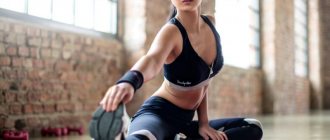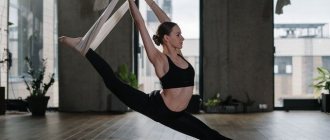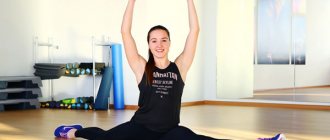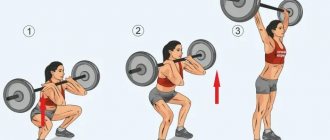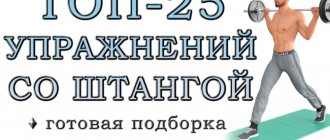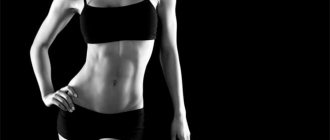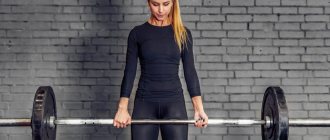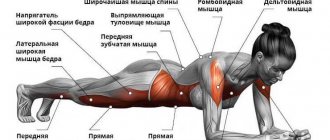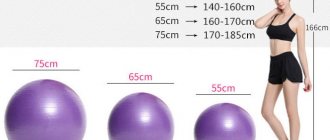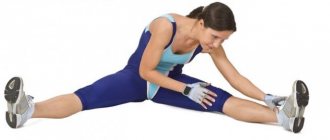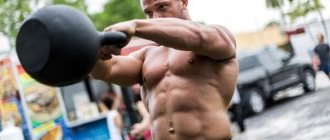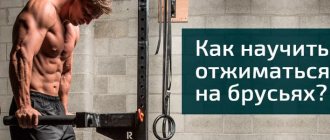Stretching the muscles of the whole body is necessary for everyone, both athletes and people with a predominantly sedentary lifestyle. Let's look at why and how to do stretching exercises.
During stretching, blood flows to the muscles, they become stronger and more elastic. Due to this, the risk of injury and pain threshold are reduced, posture and flexibility are improved. It also has a beneficial effect on the health of the vascular and nervous systems.
Experts distinguish several types of stretching, where the first 2 are main:
- Static stretching. The simplest but most effective technique. As the name suggests, the meaning lies in static poses with maximum stretching and fixation for 15-60 seconds. Necessary for developing muscle habit to a new state.
- Dynamic. There are two types: active and ballistic. The first implies smooth movements without jerking and with periodic fixation, the second - on the contrary, which has the greatest effect on the tendons.
- Proprioceptive muscle relief. Static exercises with mandatory muscle tension are essentially a warm-up before the main ones.
- Passive. Performed with the support of a partner in taking static and dynamic poses.
Warm up before stretching
When you stretch after a workout, your muscles are already warmed up and no additional warm-up is required. If you decide to arrange a separate stretching lesson, first do a few exercises:
- Joint warm-up: twirl your joints, bend and twist your body.
- 5-7 minutes of cardio: running or Jumping Jacks, Rock Climber, running in place with high knees, jumping rope.
Once you've warmed up a bit, you can start stretching.
Interesting facts about flexibility
By putting together a full set of exercises to develop flexibility, your body will experience a huge positive impact from such physical activity. It would seem that these are simple elements, but what is the effect as a result. If you're still wondering whether or not to include these exercises in your training program, be sure to check out these interesting facts about flexibility:
- The mobility of the joints of the human body develops up to 14 years of age. By the age of 17, complete stabilization occurs. Then the regression begins.
- Before 9 am the body is less flexible than at other times. But it is during this time frame that the benefits of performing the appropriate exercises are higher.
- As the temperature rises, the flexibility of the body increases. When it goes down, it decreases.
- Due to anatomical features, women are much easier to do longitudinal splits. Men sit on the transverse one faster and easier.
- The flexibility of the right and left sides of the body is significantly different.
- The effectiveness of stretching is felt after just 30 seconds of performing the appropriate exercises.
How and how much to stretch
With these exercises, you can arrange an independent stretching session and thoroughly stretch all the muscles of your body. However, it will take about 60–90 minutes. For a quick stretch, choose one or two exercises for each muscle group involved in the workout.
To give your muscles a good stretch, hold each pose for 30 seconds to two minutes. You can remain still or gently spring. Sudden movements can cause injury, so leave them for another sport.
We will give exercises for stretching from top to bottom: neck, shoulders and arms, chest and back, abs, buttocks, thighs, legs.
What are the benefits of stretching for the body (stretching)
Proponents of stretching (from the English stretch - pull) are convinced that it benefits the body and is important not only to surprise others. Some firmly believe that there is no benefit from stretching. But how are things really going?
The most important benefit of stretching is the noticeable improvement in flexibility. This can help you perform some strength exercises through the full range of motion, making them more effective.
Stretching has also shown itself to be a good rehabilitation practice for people, for example, suffering from neck or knee pain.
However, contrary to popular belief, stretching does not prevent the risk of injury if you do it before exercising.
In addition, studies have shown that stretching before the main workout can even reduce strength indicators.
But after the main active workout, it’s time to do a little stretching. This will help stretch and relax the muscles of the body and prevent or reduce pain after exercise.
Neck stretching exercises
Tilt of the head back and to the side
Tilt your head back, stretching the front of your neck. From this position, tilt your head to the left. For greater effect, place your left palm on the right side of your head, but do not press hard.
Repeat the exercise on the other side.
Head tilt forward and sideways
Place your right hand on the left side of your head. Tilt your head forward and to the side, increase the pressure with your hand.
Repeat on the other side.
Back of the neck stretch
Place one hand on the back of your head and the other on your chin. Lower your head, making a double chin. At the same time, the neck remains straight, the back of the head tends upward. You should feel tension in the back of your neck, especially at the base of your skull.
Recommendations for performing the leg stretching complex
Follow these tips and your workouts will become even more effective:
- To get noticeable results, you need to stretch regularly. 3-4 times a week will be enough.
- It is better to do a stretching complex (suples) in the evening rather than in the morning. The muscles have warmed up and stretched during the day, so it will be easier to perform the exercises.
- You need to exercise for at least 30 minutes. We hold each position from 15 seconds to 1 minute.
- Before stretching, it is advisable to warm up the muscles: do swings, squat, otherwise you can pull the ligaments and muscles of the leg.
- Static stretching is safer than dynamic stretching, but this does not mean that you cannot help yourself by swaying. However, here you need to understand moderation: there should be no sharp jerks with a large amplitude (watch the training video).
- You should not feel much painful tension in your legs. There is no need to stretch until it hurts.
- The most important thing is to try to relax in each position. Only when you relax do the muscles begin to stretch.
If you are not a very flexible person by nature and are sure that it is too late for you to do stretching and nothing will work, this is a misconception. The older a person is, the longer it may take to see visible results, but anyone can improve their flexibility.
Shoulder stretches
Front Shoulder Stretch
Place your hands behind your back, clasp your wrist with one hand and the other. Bend your elbows and lift your wrists higher. Push your chest forward and feel the stretch in the front of your shoulders.
Mid Shoulder Stretch
Grab your opposite elbow with your hand, press your shoulder towards you and pull it down. Repeat with the other hand.
Back Shoulder Stretch
Grasp your right arm with your left above the elbow, press it to your body and straighten it, lower your right shoulder down. With your left hand, pull your right hand up, lifting it with your elbow. Feel the tension in the back of your shoulders.
Repeat with the other hand.
Triceps stretch
Go to the wall, lift your left elbow up, and place your forearm behind your back. Lower your left shoulder blade down. To check that it has actually dropped and will not rise during the stretch, place your right hand below your left armpit.
Repeat on the other side.
Biceps stretch
Grab a doorknob, counter, or other support and turn your back to it. Turn your elbow upward and move your body slightly forward.
Repeat with the other hand.
Triceps and Shoulder Stretch
This pose allows you to simultaneously stretch the triceps of one arm and the front of the shoulder of the other. Place one hand behind your back from above so that your elbow points upward, and the other from below so that your elbow points to the floor. Try to bring your wrists together behind your back at the level of your shoulder blades.
Switch hands.
Wrist Extensor Stretch
Sit on your knees, place your hands in front of you so that the backs of your hands touch the floor and your fingers point towards each other. Gently shift your weight into your hands, stretching your forearms. To enhance the effect, try clenching your fists.
Swing your legs
Flexibility and elasticity are important not only in the arms and torso. Legs also need to be trained. With this exercise you will quickly restore muscle tone:
- We stand sideways to the support, leaning our hand on it. It could be a chair, a machine, a table. The main condition is that the equipment must be placed at waist level. Otherwise, there will be no effect from execution.
- We swing with a leg that is not blocked by a support.
- First we make movements back and forth, then sideways.
- We change position - we rest on the other side, and repeat the movement the required number of times with the other leg.
Chest stretching exercises
Chest stretch in the doorway
Approach the doorway, lean your elbows on the doorframes and push your chest forward, stretching your pectoral muscles.
Wall Chest Stretch
Place your hand on the wall, lower your shoulder and turn in the opposite direction. Repeat with the other hand.
Operating principle of stretching
Stretching is a movement aimed at improving the flexibility of an athlete's body. In modern medicine, it is present in the system of rehabilitation programs to restore body activity after injuries. For professional athletes, it is mandatory, as it has a preventive effect on possible sprains of ligaments, tendons, and muscles during physical activity. And even when injured, it speeds up the process of rehabilitation of the body.
Back stretching exercises
Back stretch at the counter
Stand next to a rack, exercise machine or other support, turn your left shoulder towards it. With your right hand, grab the rack high above your head and move your pelvis to the right and down, stretching the entire right side of your body.
Repeat on the other side.
Stretching the lower back muscles
Sit on the floor, move your right leg forward, left leg back. Bend your knees at an angle of 90 degrees or slightly more. Place your right hand on the floor, raise your left above your head. Pull your left leg down and back, tilt your body forward and twist towards your right leg.
Switch legs.
Back extensor stretch
Sit on the floor, bend your knees and place your feet on the floor. Grasp your shins with your hands on the inside, place your wrists on your feet. Bend forward with a round back as low as possible.
Child's pose
Sit on the floor, buttocks should touch your heels. Lean forward, lie on your stomach on your knees and extend your arms.
Downward Facing Dog Pose
Get on all fours, then move your pelvis back and up so that your body resembles an angle. Your arms and back should be stretched out in one line, your knees can be bent, and your heels can be lifted off the floor. The main thing is that your back remains straight, without rounding in the lower back.
Hanging traction
Grab a low horizontal bar and hang freely, relaxing your body. Feet should remain on the ground. Relax them, bend your knees slightly.
Inverted back stretch
Lie on the floor on your back, arms along your body, legs straight. Raise your legs and then throw them behind your head. Hands rest with elbows on the floor, hands support the lower back. Do not lean on your neck, the fulcrum is your shoulders.
A set of exercises for developing flexibility; educational and methodological material
Exercises for the shoulder joints
1. From different starting positions: arms up, down, to the sides, in front of the chest, behind the back, etc. Pulling straight arms back with springy and jerking movements; straight arm swings: unidirectional, multidirectional, simultaneous and alternate; circular movements with bent and straight arms in the lateral and facial planes.
2. Twist the shoulder joints while holding a gymnastic stick in your hands and perform them slowly with a gradual decrease in the distance between the hands.
3. In the “bridge” position, rock back and forth, bending and straightening your legs.
4. Lying in support, bending your legs, springing movements with your torso.
Exercises mainly for the spinal column
1. From different starting positions. Basic stance, legs apart: bends forward, to the sides, back, with various movements of the arms; bending forward with grabbing the legs; body turns; bending in combination with body turns; circular rotation of the body;
2. From a sitting position: legs together, apart, one leg laid aside and bent at the knee: bends forward; bends with leg grips.
3. From different starting positions: main stance, legs apart, kneeling, etc. bending backwards.
4. “Bridge” from a supine position.
Exercises mainly for the hip joints
1. From different starting positions: main stance, legs apart: alternately swing your legs forward, to the sides and back with movements of your arms.
2. From a wide stance, the feet are turned into springy deep squats.
3. From a lunge position forward and to the side: spring squats; squats with torso bends.
4. From a stop, standing legs apart, resting your hands on the floor, spring lowering the pelvis: the same, but one leg is in front, the other is behind. Lowering into splits.
A set of static exercises for flexibility
1) I.P. – lying on your back, bring your legs together, arms along your body:
- leaning on your palms, while inhaling shallowly, slowly raise your straight legs to a vertical position, and then lower them a little;
— while inhaling, jerk your legs up to the vertical and stretch out your toes, supporting your torso from the side with your hands, take a stand on your shoulder blades, your chin should rest on the upper edge of your sternum, do not close your eyes, breathing is voluntary; hold the position from 10 s to 1 min.
2) I.P. - final position of the previous exercise:
- slowly lower your straight legs behind your head, touching your toes to the floor; hold the pose for 10 seconds. up to 1 min.;
- slowly lower yourself onto your back, touching each vertebra to the floor, and also slowly lower your straight legs; take an exercise pose #1, relax.
3) I.P. – lie on your stomach, turning your head to the left or right, arms along your body:
- lie on your stomach with emphasis on your elbows, rest your chin on your fists, bending in the thoracic spine; hold the pose for 10-60 seconds.
Flexibility outdoor switchgear complex with a large rubber ball
(for the preparatory part of the lesson)
1. I. p. - o.s., ball below. 1-2 - right back, bend over - inhale; 3-4 - and. P.; 5-8 - the same on the other leg.
2. I. p. - o. s, ball forward. 1 - release the ball from your hands, squat, at the end of the squat catch the ball; 2 - i. P.
3. I. p. - o. s, ball down. 1-3 - tilt and roll the ball along the floor to the left around straight legs; 4 - i. P.; 5-8 - the same to the right.
4. I. p. - emphasis while sitting behind, the ball on the shins at the feet. 1-2 - raising straight legs, roll the ball towards the body; 3-4-lower your legs and transfer the ball to i. P.
5. I. p. - wide stance with legs apart, arms to the sides, ball on the palm of the right hand. 1 - turn the body to the right, transfer the ball to the left hand; 2 - i. n., ball in the palm of the left hand; 3-4 - the same with a left turn.
6. I. p. - o. s, ball in front of chest. 1 - jumping lunge on the right; 2 - jump into i. P.; 3-4 - the same on the left.
Flexibility outdoor switchgear complex with a gymnastic stick
(for the main part of the lesson)
1. I. p. - stand, stick below. 1 - stick on the chest; 2 - stick up; 3 - stick forward; 4 - rise on your toes; stick up; 5 — stick on the shoulder blades; 6 - stick up; 7 - lower your entire foot, stick forward; 8 - stick down.
2. I. p. - narrow stand with legs apart, stick vertically in front on the floor (support with one hand). 1-2 - squat on the left, right forward, with both hands supporting the upper end of the stick; 3-4 - and. P.; 5-8 - the same, on the right.
3. I. p. - the same. 1-3 - three swings of the right back, leaning on the stick with both hands; 4 - i. P.; 5-8 - the same, on the other leg.
4. I. p. - stand, stick below. 1 - swing left to the side, stick to shoulder to the right; 2 - i. P.; 3-4 - the same, in the other direction.
5. I. p. - stand, stick at the bottom behind. 1 - bend forward, touch the floor with a stick at the heels; 2 - i. P.; 3 - bend forward, swing the stick back; 4 - i. P.
6. I. p. - emphasis on the knees with hands resting on a stick. 1-2 - hold the ends of the stick vertically, turn the body and head to the left; 3-4 - and. P.; 5-8 - the same, in the other direction.
7. I. p. - lying on your back, stick at the top (on the floor). 1-2 - lying tuck, stick on the shin near the insteps; 3-4 - and. P.
8. I. p. - gray hair, stick on chest. 1 - sit at an angle, stick to toes; 2 - swing the legs apart onto the stick; 3 - the same, back; 4 - i. P.
| № | Contents of the exercise | Dosages ka | Organizational and methodological instructions |
| 1. | I.p. - stand with your legs apart, hands on your belt. 1-3 - 3 springy tilts of the body to the left, right arm up, 4 - i.p., 5-7 - 3 springy torso tilts to the right, left arm up, 8-i.p. | 8 times | Keep your arm straight at the top. |
| 2. | I.p. - sitting on the floor. 1-3 - 3 spring forward tilts, 4 - i.p. | 6 times | Reach your chest with your knees, keeping your legs straight. Bend forward with the help of a teacher who presses his hands in the area of the shoulder blades. |
| 3. | IP - gray haired on the floor. 1-3 - emphasis lying behind, bending over. 4 - i.p. | 6 times | |
| 4. | IP - gray haired on the floor. 1 - sitting with legs bent, 2- lift your pelvis off the floor 3-4 – i.p. | 6 times | Try to touch your heels with your buttocks, arms straight. |
| 5 | I.p. – lying on your stomach, on the floor, arms bent at your chest. 1-4 – slowly straighten your arms, bend over, 5-8 - i.p. | 6 times | |
| 6. | I.p. - lying on your back, arms along your body. 1-3 - lift your right leg up, grab it with your hands, smoothly pull it towards your body, 4 - i.p. 5-7 - raise your left leg up, grab it with your hands, smoothly pull it towards your body, 8-i.p. | 6 times | |
| 7. | I.p. - stand with legs apart. 1- right hand up, left hand down, 2-3 - bend your arms back and connect your fingertips, 4-i.p. | 6 times | |
| 8. | I. p. - stand with legs apart. 1-4 - circular movement of the body to the right, 5-8 - circular movement of the body to the left. | 6 times | |
| 9. | I.p. - lying on your stomach, legs apart, grab your shins with your hands from the outside. 1-2 - bend in the back, 3- stay in this position for 2-3 s, 4- i.p. | 6 times | |
| 10 | Standing facing the gymnastics wall, place your right foot on the bar at waist (or chest) height and, leaning forward, strive to touch your leg with your chest. | 10 times |
A set of static exercises for flexibility
1) I.P. - sit on the floor, legs forward, then bend your left leg at the knee and press the sole of your foot to the inner surface of your thigh so that your heel is near your groin and your knee is pressed to the floor.
— while inhaling, lean forward and grab your left (right) foot with your hands;
- tilt your head forward and rest your chin on your sternum, keep your back straight;
- take a deep breath and hold your breath. Try to pull in your buttocks and stomach;
- hold the pose while holding your breath for 0.5-1.5 minutes, then relax and inhale, protruding your stomach, repeat the breathing cycle 1-2 times;
- exhale, raise your head, lower your feet with your hands, raise your torso to the vertical and straighten your bent leg;
- perform the exercise on the other leg, then lie on your back and relax.
2) I.P. – sitting on the floor, legs extended forward, then take the left leg to the side and bend at the knee joint so that the left thigh is perpendicular to the right leg:
— while exhaling, bend over with your right side, grab the toes of your right foot with your left hand, and place your right forearm on the floor along your right shin. Hold the pose for 10 -30 seconds;
- straighten your torso, grab your left knee with both hands and, as you exhale, bend towards it, falling lower and lower;
— fix the torso in a maximum tilt for 10-30 seconds and then straighten it.
3) I.P. – sit down, legs forward: pull your feet towards the perineum, bending your legs at the knee joints; connect the soles of your feet and lower your knees; pressing your elbows and forearms on your shins, press your knees to the floor; inhale, as you exhale, bend down and then lower your head, trying to touch your forehead to the floor; hold the pose for 1-2 minutes.
Spread twine.
The spread split is an unrivaled muscle stretching exercise for rock climbers and ballet dancers. Once you have gained some skill in performing the “seated groin stretch,” you can carefully shift your body weight to your elbows. Your hips will be raised relative to the floor and your legs will form a straight line when viewed from above. Slowly transfer your body weight to your legs and “press” your feet onto the floor. When the tension is relieved, the legs will move apart a little more to the sides. Shift your body weight to your elbows and “push the walls” with your legs even further. Bending your knees while performing any type of straight (transverse) split leads to injuries and damage.
Picture 1
Stretch your arms forward, lie flat on the floor, in this “spread out” position you can turn your upper body to the sides from time to time to slightly increase the range of motion.
Straight (transverse) twine.
“Dead split,” this is what special forces call in Russia a straight (transverse) split with the toes of the feet pointing forward.
Figure 3
“Push the walls” and – this is very important – push your hips forward. Three positions for hand support are offered. You can give the correct position to the hips in a position with support with one hand in front and the other behind relative to the body; you can lean your hands on the floor in front of you and pull your hips forward; or, if there is enough flexibility, then moving your arms back for support, behind your back, pushing your hips forward.
Exercise.
Starting position: sitting in a cross split, move your right arm to the side, then up and grab your left foot. The left hand is pressed to the floor and extended towards the right leg. Hold for 20-30 seconds, then do the same in the other direction.
Figure 3
Longitudinal twine.
- Get down on one knee. Look forward, keep your pelvis straight. Stretch your spine upward, “opening” your chest as you inhale.
- As you exhale, bend forward and lower your hands to the floor. Stretch your entire spine without straining your shoulders and neck.
- Take a breath. As you exhale, slowly slide your front leg forward, transferring the weight of your body to your arms. Move your pelvis forward as far as possible, straighten your back leg. The back knee should be directed towards the floor, the forward knee should be directed towards the ceiling.
- Lower your pelvis and take a few breaths. Raise your arms above your head, placing your palms together. Pull the back of your body up. Stay in this position for a few seconds before relaxing. Return to the starting position and repeat, changing the position of your legs.
Figure 4
Exercise.
- Lie on your stomach, on the mat, bend your right leg under you, left leg straight. Place your hands on the floor and lift your torso. Keep your pelvis straight so that your lower back only stretches slightly.
- Bend your left leg. As you inhale, stretch your entire spine up and back. Extend your right arm above your head and, as you exhale, grab your left foot.
- Holding your left foot tightly, raise your left hand above your head and also grab your foot with it. As you exhale, bend your thoracic spine, stretch your neck and tilt your head back until the crown of your head touches your foot. Stay in this position for a few seconds, then lower your arms one by one. Inhale and slowly raise your head.
Figure 5
Exercise.
- On your knees, reach up. Moving your head back, bend back, arching your thoracic spine and “opening” your chest.
- Continue stretching backwards with your arms bent. Do not tilt your pelvis back so that the weight rests on your knees and feet. Stretch slowly, controlling your movements.
- Grasp your feet with your hands, chest “opened”, pelvis still pushed forward. Bend over so that your head rests on your feet and your elbows on the floor. Stay in this position for a few seconds, then return to the starting position.
Figure 6
Exercise in the dog position.
Angle emphasis on legs and arms. From a kneeling position, straightening your legs, move to a point-blank position - your torso and head are on the same line.
Options:
A – Performed on one leg, the other bent. B – On one leg, the other up.
Figure 7
Abdominal stretching exercises
Camel Pose
Get on your knees, push your chest up, lengthening your spine, and then lean back, placing your hands on your heels. Try to bend in the thoracic region. Don't throw your head back, look up.
Upward-facing dog pose
Lie on the floor on your stomach, place your hands under your shoulders. Push yourself up, your pelvis rises, your legs remain on the floor. Lower your shoulders, bend in the chest.
Standing Backbend
Stand straight with your feet together. Raise your arms and join your palms above your head. Bend your chest and tilt your body back. Tighten your buttocks to prevent a strong arch in your lower back.
Side tilt
Stand up straight, raise your arms above your head, clasp your fingers and turn your palms up. Stretch up and bend first to one side and then to the other.
Lying spinal twist
Lie on the floor on your back, arms out to the sides, palms down. Move your pelvis to the left, lift your left leg, bending it at the knee, move it behind your right leg and try to place your knee on the floor. Turn your head to the left and relax.
Repeat the exercise on the other side.
Joint gymnastics: 10 exercises
Why do you need joint gymnastics? Joint exercises improve blood circulation and warm up the muscles of the whole body, which is especially important before performing a set of stretching exercises, since stretching on an unstretched body is unsafe. In addition, exercises from joint gymnastics warm up and develop joints, making them more mobile.
If you plan to do stretching exercises after an active workout, then in principle you can skip joint exercises. If your workout begins with stretching, then before stretching you must perform joint exercises.
Our joint gymnastics includes 10 exercises. Perform each exercise for 30 seconds without resting between exercises if you are training on a timer. Or count the number of repetitions if you train without a timer. See also: A selection of exercises for joint gymnastics.
Head turns
Stand straight, hands on your waist. Start tilting your head: right - forward - left - forward. Perform this exercise at a slow pace, without making sudden jerks with your head.
How much: 10 turns to the right and 10 turns to the left or 30 seconds.
Wrist rotation
Bend your elbows in front of you and clench your palms into a fist. Start rotating your hands in a circle, stretching your wrists well. Rotate first in one direction, then in the opposite direction (clockwise and counterclockwise).
How much: 10 rotations in each direction (20 rotations in total) or 15 seconds per rotation in one direction (30 seconds in total per exercise).
Elbow rotation
Leave your palms folded into a fist and spread your arms out to the sides. Start rotating your forearms, stretching your elbow joints. Rotate first in one direction, then in the opposite direction.
How much: 10 rotations in each direction (20 rotations in total) or 15 seconds per rotation in one direction (30 seconds in total per exercise).
Shoulder rotation
Let's move on to warming up the shoulders. Lower your arms along your body and begin to rotate your shoulders, trying to describe the maximum circle with them. Rotate your shoulders first forward, then back.
How much: 10 rotations in each direction (20 rotations in total) or 15 seconds per rotation in one direction (30 seconds in total per exercise).
Hand rotation
Stay in the same position and begin to rotate your arms with maximum amplitude. Rotate your arms first forward, then back.
How much: 10 rotations in each direction (20 rotations in total) or 15 seconds per rotation in one direction (30 seconds in total per exercise).
Body tilts
Let's move on to warming up the core. Place your hands on your belt and begin to bend, first in one direction, then in the other.
How much: 10 bends in each direction (20 bends in total) or 30 seconds per exercise.
Pelvic rotation
Leave your hands on your waist and begin to rotate your pelvis in a circle. Stretch your buttocks, thighs and stomach. Don't forget to rotate first in one direction, then in the opposite direction.
How much: 10 rotations in each direction (20 rotations in total) or 15 seconds per rotation in one direction (30 seconds in total per exercise).
Hip rotation
Let's work the hip joints. Hands are on the belt. Raise your knee and begin to rotate your leg. First, rotate your right foot (one way, then the other way). Then rotate your left leg (one way, then the other way).
How much: 8 rotations on each leg forward and the same amount backward (total 16 rotations on each leg) or 30 seconds on each side.
Knee rotation
Place your feet together, bend your body and place your hands on your knees. Start rotating your knees, warming up your knee joints.
How much: 10 rotations in each direction (20 rotations in total) or 15 seconds on each side (30 seconds for the entire exercise).
Rotation of the feet
Place your hands on your waist again and lift your knee. Start rotating your foot, stretching your ankle joint. Remember to rotate to one side and the other on each leg.
How much: 10 rotations in each direction (20 rotations total on each leg) or 15 seconds per rotation in each direction (30 seconds on one leg or 60 seconds on both legs).
Exercises for stretching the buttocks
Lying stretch
Lie on the floor on your back, raise your knees bent. Place the ankle of your left foot on the knee of your right. Press the knee of your right leg onto your left to deepen the stretch. Repeat with the other leg.
Stretch on all fours
Get on all fours, place your right ankle on your left knee. Push your pelvis back to deepen the stretch. Repeat with the other leg.
Stretching while sitting
Sit on the floor, stretch your legs forward, straighten your back. Bend one leg at the knee, grab your shin with your hands and press it to your chest. The shin should be parallel to the floor, the forearms lie on top and press it to the chest, one hand covers the other.
Repeat with the other leg.
Pigeon pose
Sit on the floor, bend one leg at the knee at a right angle and move it forward, take the other back and straighten it. You can lean forward and place your forearms on the floor.
If you have difficulty doing this pose on the floor, try placing your foot on an elevated platform.
Is it possible to lose weight from stretching?
No matter how strange it may be, stretching really helps to lose weight if you do the complex correctly, regularly, and for at least an hour. The load on muscle fibers during traction burns subcutaneous fat due to the supply of oxygen to the tissue. Therefore, by stretching, you can lose no less in volume than with cardio training. Of course, you should pay attention to nutrition. A high-calorie diet will ruin all your efforts.
Exercises to stretch the front of the thigh
Lying quadriceps stretch
Lie on the floor on your stomach, lift one leg and place your hand on your ankle. Pull your leg towards your buttock, trying not to lift your thigh off the floor. Repeat with the other leg.
Single Knee Quadriceps Stretch
Get down on one knee, grab the toe of your back leg with your hand and pull your heel towards your buttock. Squeeze your gluteal muscles: this will deepen the stretch. Repeat with the other leg.
Hip flexor stretch
Get on one knee with both legs bent at a 90-degree angle. The back is straight. Tighten your gluteal muscles and move your pelvis slightly forward. You should feel tension in the front of your back leg and in your groin.
Switch legs.
Deep Lunge
Take a deep lunge forward. Place your fingers on the floor on either side of your foot. Lower the knee of the straightened leg to the floor. Try to go lower and do not turn your pelvis to the side.
Switch legs.
Why you need to develop flexibility
Elastic muscles and flexibility of the whole body are not only physical development, but also the health of the body as a whole:
- A sedentary lifestyle and constant use of the computer leads to stagnation in the circulatory system, back pain and muscle tension, which negatively affects the functioning of the spine. Performing stretching, even the most basic, allows you to restore blood flow and start all the most important processes in the body.
- Constantly tense muscles increase the risk of injury several times. With more flexible and mobile joints, the risk of various injuries is sharply reduced.
- It has been scientifically proven that the lack of elasticity and flexibility of muscle fibers negatively affects a person’s emotional state. Exercises for stretching the back and other parts of the body relieve not only stiffness, but also stress and moral tension.
If you have led a sedentary lifestyle for many years, the results of stretching will be visible after just a few sessions.
Exercises to stretch the back of the thigh
Hamstring stretch with expander
Lie on the floor, leave one straight leg on the floor, raise the other. Place an expander, jump rope or rope over your foot and pull your leg towards you. Switch legs.
Stretching while standing
Stand up straight, take a step forward. Tilt your body almost parallel to the floor. If you leave the leg straight, the upper part of the back of the thigh is stretched more; if you slightly bend the leg at the knee, the lower part is stretched.
Repeat with the other leg.
Tilt to feet
Sit on the floor, stretch your legs straight forward. Bend towards your feet and place your hands on either side of your feet or slightly further away. To deepen the stretch, you can straighten your back for a few seconds and then bend down again.
Bend to one leg
Sit on the floor, stretch one leg forward, bend the other at the knee and place your foot next to your pelvis. Bend towards your straight leg, grab your foot with your hands and pull the toe towards you. Try not to round your back.
Repeat with the other leg.
Bend while standing
Spread your legs wider, toes pointing forward. Lower your body down, keeping your back straight, until you place your palms on the floor.
Longitudinal twine
Split into a side split so that your iliac crests point forward. Place your palms on the floor and support your body weight on your hands. Try not to turn your hips and shoulders to the side.
Head tilts
This exercise can easily be classified as a warm-up exercise, but when you do it, you will quickly understand how effective it is in increasing elasticity. The technique is simple:
- We take a standing position - we place our legs at a short distance from each other, our arms are lowered along the body.
- We do an exercise - we alternately tilt our heads in different directions. The choice of direction is determined individually: clockwise or counterclockwise, with alternating sides.
Inner Thigh Stretching Exercises
Deep squat
Stand next to a rack or machine that you can hold on to. Feet shoulder-width apart, toes and knees turned outward. Lower yourself into a deep squat, keeping your back straight.
Butterfly near the wall
Sit on the floor with your back straight, fold your legs in front of you with your feet facing each other. Try to lower your knees to the floor, but do not put pressure on them with your hands. Keep your back straight.
Frog
Lie on the floor on your stomach, spread your knees to the sides and bend your legs at a right angle. Try to place your pelvis on the floor.
Frog with straight leg
Lie on the floor on your stomach, spread your knees out to the sides so that your thighs are parallel to the floor. Bend one leg at the knee, straighten the other. Try to place your pelvis on the floor. Repeat with the other leg.
Forward fold
Sit on the floor, spread your straight legs wider, and then lean forward. Try to lie on your stomach on the floor, do not bend your knees.
Cross twine
vova130555/ru.depositphotos.com
Split into a cross split. Do not move your pelvis too far back; ideally it should be in line with your knees and feet. Place your palms on the floor, and if stretching allows, your forearms. Pull your pelvis down towards the floor.
Stretching next to the wall
Lie on the floor close to the wall. The body should be perpendicular to it. Spread your legs and let them slowly lower under your weight. Stay in this position for 5–10 minutes.
Twist
This movement belongs to a set of exercises with a gymnastic stick. If this equipment is not at hand, you can take any oblong object (even a rolled up large towel will do). Technique:
- We take a vertical position. We take the equipment in our hands with a wide grip.
- We pull our arms completely straight up, then twist the shoulder joints back, pulling them together with the stick.
- We do the required number of repetitions.
Helpful advice. To get the desired effect, we gradually complicate the exercise. To do this, you need to reduce the grip distance with your hands.
Exercises to stretch the outer thigh
Hip abduction
Stand next to a wall, turning your right side towards it. Place your right leg behind your left and squat down. The left leg bends, the right leg remains straight and moves further to the left. The straight body hangs over the left leg.
Repeat on the other side.
Stretching while standing
Place your left leg behind your right in front and lean to the left. You can place one hand on your belt, fold your arms above your head or in front of you. The more the body tilts, the better the muscles stretch.
What are the benefits of stretching in the morning for men and women?
- Improves blood circulation and active blood flow to organs.
- Protects against nerve endings.
- Relaxes the vertebrae and strengthens the spinal corset with the back muscles.
- Promotes general relaxation of muscles and the whole body.
- Eliminates sensations of swelling and numbness in the limbs.
- Morning stretching has a positive effect on blood pressure and overall coordination of movements.
- Promotes active awakening of the body: night cramps and tension are eliminated, all tissues, organs and muscles are saturated with oxygen.
- Improves performance, concentration, and focus.
- Lethargy, drowsiness, and bad mood in the morning disappear.
Calf Stretching Exercises
Stretch against the wall
Press the toe of your right foot against the wall, take your left foot a step and a half back. The feet are pressed tightly to the floor, the left leg is straight. Try to reach the wall with your right knee, this will stretch the muscles of your left leg.
Switch legs.
Heel Wall Stretch
Stand close to the wall. Place your right toe on the wall, take your left leg a step and a half back. Bend your left leg at the knee, increasing the stretch. Switch legs and repeat.
Stretching for Beginners: Where to Start
- To begin with, do not choose technically complex exercises, start with simple ones. The main thing in stretching is to relax the muscles, return them to their normal state, and the sensations should be pleasant, not painful.
- Always warm up well. Don't stretch cold muscles - this is the first step to injury. Read more about warming up before stretching →
- Start training with 30 minutes, then gradually increase the duration of each exercise, increasing the training time to one hour.
Kinds
Stretching is classified according to two parameters - the degree of load performed and the method of performing the selected exercises.
According to the degree of load, stretch exercises are divided into:
- ON SOFT. Muscles stretch during exercise only to their physiological length. Each exercise takes 30-40 seconds;
- DEEP. A whole set of exercises is performed, the purpose of which is to stretch the muscle fibers to an unusual length. The duration of each exercise is 1-5 minutes.
According to the method of execution, stretching is divided into:
- STATIC. The exercise consists of slow and smooth movements. By straining a certain group of muscles, the training person briefly hangs in this position, that is, the muscles are in a contracted form and receive a static load. Static exercises help stretch and strengthen muscles; it is recommended to start training with them;
- DYNAMIC. A set of exercises is selected, during which the muscles first tense and then relax;
- BALLISTIC. It is based on swinging exercises for the limbs, performed with increasing amplitude and speed. This helps to quickly stretch the muscles of a certain part of the body. Ballistic stretch exercises should be performed after special training, since beginners often get injured when performing them;
- SLOW. Exercises are performed at the slowest pace possible. Allows you to stretch muscle fibers and is used as a warm-up option before performing a strenuous workout;
- PAIRS. A partner helps stretch those muscle groups that are difficult to work without outside help.
There is another type of stretching – proprioceptive neuromuscular. Its main goal is to restore the functionality of joints and muscles after surgery or injury. It is carried out under the supervision of rehabilitation specialists and allows you to correct disorders caused by incorrect posture and damage to the musculoskeletal system.
Contraindications
Stretching is contraindicated:
- During the recovery period after injuries and severe diseases of the spine;
- For fractures;
- During the period of exacerbation of inflammatory and degenerative diseases of muscles, tendons and ligaments;
- People with severe varicose veins;
- People with decompensated stages of pathologies of the cardiovascular system.
Stretching can also be used as physical therapy, but in this case, sets of exercises should be selected only by a doctor and carried out under the guidance of an experienced specialist.
Benefit
Stretching exercises have gained popularity not only due to the ease of their implementation and the possibility of training at any age. Regular exercises contribute to:
- While working out almost all muscle groups of the body, regular fitness does not give this result;
- Removing nerve and muscle blocks in all parts of the body, which reduces pain. Many women note a decrease in pain during menstrual periods when doing exercises;
- Activation of the work of peripheral vessels, due to this, congestion is eliminated, and, accordingly, the development of such dangerous pathologies as thrombosis and atherosclerosis is prevented;
- Reduce salt deposits. Stretching is one of the most effective ways to prevent hypokinesia and osteoporosis;
- Straightening posture, correcting figure volumes;
- Increasing self-esteem, relieving mental stress;
- General rejuvenation of the body.
Stretch exercises can be performed at any time of the day. They can be done during cardio training and strength training. The first results of the classes become clearly noticeable within a month - without problems or difficulties, people sit in the lotus position, bend without tension, and become more resilient.
Cloth
You should exercise both at home and in the gym in specially selected clothes. It should be made of durable and at the same time elastic materials. The trainee should not feel that the clothes are tight, pressing, or making it difficult to move.
It is best to purchase a suitable suit at specialized sales points, where sales consultants can select shorts, leggings, tops, T-shirts, based on the type of expected load, size, and comfort.
General rules for performing stretch fitness
- The body must be stretched only to a certain limit; the appearance of pain must be perceived as reaching the maximum in overstretching of the muscle fibers. There should not be any severe pain;
- Before stretch exercises, you should do a comprehensive warm-up for the whole body, this ensures a rush of blood to the muscles and increases elasticity;
- You need to monitor your breathing, it should be smooth, rhythmic, there is no need to emphasize inhalation and exhalation. Exhale when bending, inhale air while stretching. It is recommended to breathe deeply while changing positions;
- Each pose taken is held for 10-30 seconds;
- During exercise, you must maintain a stable position.
After stretching, the muscle fibers should be in a relaxed state, so strength training should not be performed.
